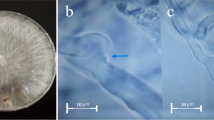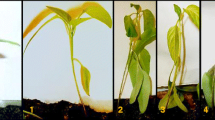Abstract
Six extracts from plant material (Galla chinensis, Potentilla erecta, Rheum rhabarbarum, Salviae officinalis, Sophora flavescens, and Terminalia chebula) were tested for controlling effects against the infection of Phytophthora infestans on detached potato leaves, seedlings, and tuber slices. On detached leaves, G. chinensis (2%), R. rhabarbarum (rhizome, 2%) and S. flavescens (2%) extracts showed a significant control effect, with a control efficacy of 96.67%, G. chinensis was the best. On seedlings R. rhabarbarum (rhizome, 2%) showed the best inhibiting effect, followed by S. flavescens (2%), T. chebula (1%), and G. chinensis (2%). The control efficacies were 91.67%, 75.00%, 70.24%, and 64.29%, respectively on the seventh day after inoculation. However, on potato slices, none of the plant extracts showed effective protection against infection and sporangia production by P. infestans. The reason was analyzed and the potential for developing a natural fungicide based on these plant materials was discussed.
Similar content being viewed by others
References
Blaeser P, Steiner U (1999). Antifungal activity of plant extracts against potato late blight (Phytophthora infestans). In: Lyr H, Russel P E, Dehne H W, et al, eds. Modern Fungicides and Antifungal Compounds II: 12th International Reinhardsbrunn Symposium. Friedrichroda, Thuringia, Ge: 491–499
Cao K Q, Ariena H C van Bruggen (2001a). Inhibitory efficacy of several plant extracts and plant products on Phytophthora infestans. Journal of Agricultural University of Hebei, 24(2): 90–96 (in Chinese)
Cao K Q, Forrer H R (2001b). Current status and prosperity on biological control of potato late blight (Phytophthora infestans). Journal of Agricultural University of Hebei, 24(2): 51–58 (in Chinese)
Ding Y L, Xu A X (2004). The medicinal use of Rheum rhabarbarum. China Pharmaceuticals, 13(5): 80–81 (in Chinese)
Hou H C, Liang Q, Lu X C (2005). Determination of gallic acid in Galla chinensis and Galla halepensis by HPLC. Drug Standards of China, 6(3): 38–39 (in Chinese)
Li H M, Huang R Q, Hao J G, Jia J F (2004). Influence of producing area and plant age on oxymatrine content in root of Sophora flavescens. Chinese Traditional and Herbal Drugs, 35(4): 448–452 (in Chinese)
Quintanilla P, Rohloff J, Iversen T H (2002). Influence of essential oils on Phytophthora infestans. Potato Research, 45(2/4): 225–235
Yang H X, Ma Q Y, Yang L S (2003). Study on antioxidative effects of the extracts of tea, myrobalan and some other plants. Journal of Zhengzhou University (Medical Sciences), 38(3): 413–415 (in Chinese)
Yang Y H, Gesang S L, Wu J K (2004). Studies on the plant taxonomy and pharmic characters summary of Terminalia chebula, T. bellirica and Phyllanthus emblica. The Chinese Academic Medical Magazine of Organisms, (1): 14–28 (in Chinese)
Author information
Authors and Affiliations
Corresponding author
About this article
Cite this article
Wang, S., Hu, T., Zhang, F. et al. Screening for plant extracts to control potato late blight. Front. Agric. China 1, 43–46 (2007). https://doi.org/10.1007/s11703-007-0007-x
Received:
Accepted:
Issue Date:
DOI: https://doi.org/10.1007/s11703-007-0007-x




